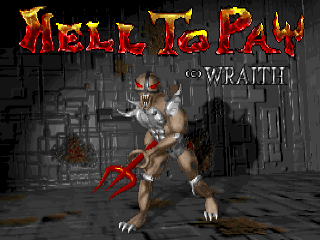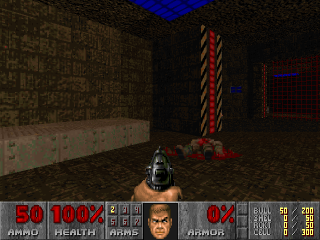Overview
 Hell to Pay Title Screen
Hell to Pay Title ScreenHell to Pay (alternately referred to as Hell 2 Pay) is a 32-level retail expansion scenario for Doom II, and the second of two such efforts developed by Wraith Corporation and published by WizardWorks Software in 1996. Built on the Doom Engine, Hell to Pay is categorized as a partial conversion due to the fact this it uses assets lifted from Doom and its sequel in conjunction with original ones created specifically for the game. Among these additions are new weapons, enemies, textures, and music. Hell to Pay is an unusual case among the Doom series' unofficial expansions, which by and large consisted of user-created maps (often gathered from the internet) loosely cobbled together without regard to the cohesion or quality of the final product. By contrast, Hell to Pay from its inception was intended to provide a unified experience on par with or exceeding that of the original games. To this end, Hell to Pay's creators set out to build maps that were evocative of actual locations, often populating them with recognizable objects like forklifts and dining tables. Wraith further attempted to immerse the player by including brief updates between missions, which detailed the player's exploits in the fight against the intergalactic hellions.
Story
 Aliens beware! There's gonna be Hell to Pay!™
Aliens beware! There's gonna be Hell to Pay!™The events of Hell to Pay are set some two hundred years after a solitary human marine successfully thwarted a demon invasion by single-handedly fending off the legions of Hell. In the intervening period, Earth became an idyllic place as nations around the world, realizing how dangerously close they had come to total annihilation, agree to disavow warfare altogether. This paradise would be tragically short-lived, however, as an unknown alien race would one day unexpectedly appeared near Jupiter and quickly establish a base of operations on Io. While many initially looked to their appearance with optimism, it soon became apparent that the new arrivals' true purpose was to violently colonize the planet. Strange creatures and robotic constructs soon overran the globe, with the death toll reaching into the billions. The few who were spared lived only to be enslaved, working in hellish labor camps under nightmarish conditions. Those too infirm or unfit to work were simply led away, never to be seen again. To make matters worse, certain unconscionable individuals with no sympathy for the plight of their fellow man began to volunteer themselves for indoctrination, becoming "trustees" who kept their brethren in line for the sake of their masters.
A decade has passed since the initial invasion, though humanity still toils endlessly for the benefit of its alien overlords. The protagonist of Hell to Pay is a slave and would-be revolutionary whose plan of escape is prematurely discovered by an alien trustee. Rather than accept that he will eventually be executed, he pounces on his trustee guard, killing him and taking his pistol before striking out to retaliate against the ICF (Infernal Colonization Forces). His quest to free his kin from the shackles of colonial oppression will lead him on a path through occupied Earth, across the galaxy to the enemy moon base on Io, and eventually to Planet Hell itself, homeworld of the infernal interlopers.
Gameplay
Gameplay in Hell to Pay will be immediately familiar to anyone versed in the style of play popularized by Doom and its derivatives. From the first-person perspective, players battle their way through a series of increasingly difficult levels, facing larger numbers and tougher enemies as they progress. Levels can be completed simply by finding the exit, though maps customarily place these exits behind a number of obstacles (monsters, locked doors, etc.), requiring the player to often seek out red, blue, and yellow keys while traversing complex environments and fending off enemy attacks. More powerful weapons become available over time so that players will have ample means with which to deal with more dangerous foes, and additional bonus items can often be found stashed away in hidden areas contained in each level. After completing a map, players are rated on the percentage of items and secrets found, percentage of enemies killed, and the total time it took the player to complete the level.
While most enemies present in Doom II make appearances in Hell to Pay, a select number of enemies (namely the Imp, Demon, Spectre, Cacodemon, Lost Soul, Mancubus, and Pain Elemental) are omitted in favor of new ones. Reflecting the more technological leanings of Hell to Pay's antagonists, these new foes are all automata of one form or another. The additional monsters do not yield any appreciable effect on gameplay outside of their own novelty, however, as their attacks, behavior, and hit points are all directly analogous to that of the monsters they replace. Hell to Pay also includes three new weapons, which replace the Rocket Launcher, Plasma Gun, and BFG 9000. As with the enemies, the new armaments are a cosmetic change only, as they are functionally identical to the old ones.
Log in to comment